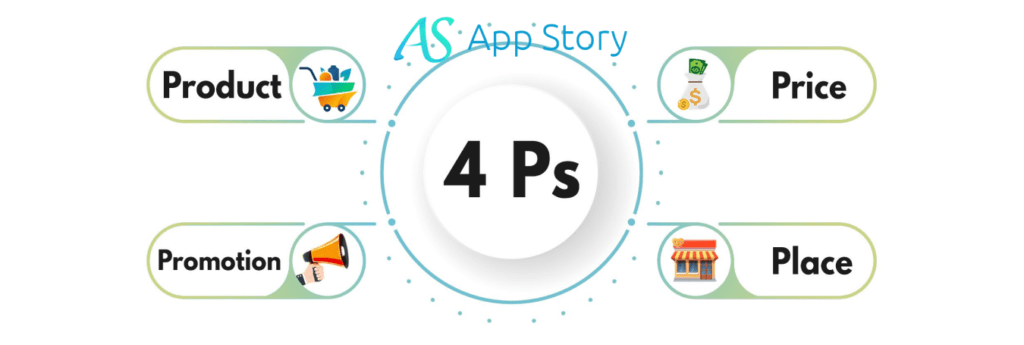Starting a business? Brace yourself—it won’t be easy. But even with limited resources, you can thrive. Key to success? Low-cost marketing strategies. Overlook them, and your business could falter.
As per the records of the U. S. Bureau of Labor Statistics, 20% of small business fail in their first year of formation. And you certainly don’t want to be 1 out of them!
This clearly emphasizes the fact that the initial stage of a business is the most crucial part of its life. At this stage, you will need to develop your 3 P’s i.e., product, practices, and promotions. All three P’s must combine to be the best for your business.

Here are the four Ps of creating a marketing strategy:
- Product
- Price
- Place
- Promotion
Sure, let’s delve into each of the four Ps of creating a marketing strategy in depth:
1. Product
Definition: The product is the tangible good or intangible service that meets the needs or wants of customers.
Key Considerations:
- Product Design: Features, quality, and benefits that differentiate it from competitors.
- Branding: The image and identity associated with the product.
- Packaging: How the product is presented to the consumer, which can affect perception and convenience.
- Lifecycle: Understanding the stages of the product lifecycle (introduction, growth, maturity, decline) to adapt marketing strategies accordingly.
- Innovation: Regular updates or new versions to keep the product relevant.
Strategies:
- Conduct market research to understand customer needs and preferences.
- Develop unique selling propositions (USPs) to differentiate the product.
- Invest in quality and design to enhance customer satisfaction and loyalty.
2. Price
Definition: The amount of money customers must pay to acquire the product.
Key Considerations:
- Pricing Strategy: Choosing between various pricing strategies like cost-plus pricing, value-based pricing, penetration pricing, and skimming pricing.
- Cost: Understanding the costs involved in production and distribution to set a profitable price.
- Perceived Value: Aligning the price with the perceived value to the customer.
- Competitive Pricing: Analyzing competitor pricing to position your product competitively.
- Discounts and Promotions: Deciding when and how to use discounts, sales, and special offers to boost sales without eroding profit margins.
Strategies:
- Perform a break-even analysis to understand the minimum price needed to cover costs.
- Use psychological pricing tactics (e.g., $9.99 instead of $10.00) to influence buying decisions.
- Consider dynamic pricing models to adjust prices based on demand and market conditions.
3. Place
Definition: The locations and methods used to make the product available to customers.
Key Considerations:
- Distribution Channels: Selecting the right mix of direct (e.g., online stores, company-owned retail outlets) and indirect channels (e.g., wholesalers, retailers).
- Logistics: Efficiently managing inventory, warehousing, and transportation to ensure product availability.
- Market Coverage: Deciding between intensive distribution (wide availability), selective distribution (limited outlets), or exclusive distribution (single or few outlets).
- Channel Partners: Building strong relationships with distributors, retailers, and other partners.
Strategies:
- Evaluate the benefits of different distribution channels and select the ones that align with your product and target market.
- Implement effective inventory management systems to balance supply with demand.
- Use technology to streamline logistics and improve distribution efficiency.
4. Promotion
Definition: The activities and tactics used to communicate the benefits of the product and persuade customers to purchase it.
Key Considerations:
- Advertising: Utilizing various media (TV, radio, online, print) to reach target audiences.
- Sales Promotion: Short-term incentives like discounts, coupons, contests, and free samples to stimulate immediate sales.
- Public Relations: Building a positive image and managing relationships with the public through events, sponsorships, press releases, and community involvement.
- Personal Selling: Direct interaction between sales representatives and potential buyers to build relationships and close sales.
- Digital Marketing: Leveraging online platforms, social media, email marketing, and SEO to reach and engage customers.
Strategies:
- Develop a comprehensive promotional mix that uses a variety of tactics to reach different segments of the target market.
- Create compelling messages and content that resonate with the audience and highlight the product’s benefits.
- Measure and analyze the effectiveness of promotional activities to optimize future campaigns.
Integration of the Four Ps
A successful marketing strategy integrates these four Ps to create a cohesive plan that aligns with the company’s overall objectives. The right balance and combination of product, price, place, and promotion tailored to the target market can significantly enhance the product’s market performance and drive business growth.
10 Marketing Strategies to Fuel Your Small Business Growth
Promotion is Prime!
None of us can deny the fact that prodigious promotion strategies are the ultimate key to unlock the doors of success. Promotion means the marketing of your product or service to rope in new clients into your business. Most of the surveys conducted to examine the importance of marketing has come to a conclusion that marketing is one area that involves substantial investments and marketing has to be strategized in order to make the most out of such investments.
However, it would not be feasible for a new concern to invest in marketing as heavily as a well-established business. So today, we shall guide you on 7 low budget marketing techniques which will help you turn heads towards your business without burning a hole in your pocket.
Let’s scroll through:
Being a guest on a better-known site – Guest Posting
This has to take the first place on our list. A forgotten and very less used marketing technique by young businesses that has the potential for a great turnout. When a business is new, your people must know about it and there’s nothing better than a valuable article on a website that already has several followers who might be interested in your product or service. In fact, 57% of marketers say that they have gained customers through blogging.
You just need to find the right website. A website that meets the nature of your product or service is trusted by people and attracts a lot of traffic can be an ideal site to start with guest posting. These websites usually charge a fee which is pretty less as compared to other alternatives. Practically, what more would you want? – Low cost, traffic, and awareness!
Don’t be local, go social – Social Media Marketing
Social media is if not the first, certainly the second-best alternative for you. Most of the social media platforms are free and own a lot of potential for greater approach.
All you would need is an account on major social media platforms, a good portal to design your posts and you can right away start posting about your products and services. Canva has been the absolute favorite for many when you talk about portals that are specifically designed to craft extraordinary designs – they have a huge range of designs to choose from and the ease-to-use is just exemplary!
Social media will allow you to meet new people from across the globe. You can enter into meaningful conversations with them and build a reputation for your business. You can deliver great value to people and let them understand your business much better. Social media is a great way to keep your clients updated about your latest trends. In reality, 73% of the marketers believe Social Media Marketing has been very effective for them.
Let others do it for you for a consideration – Pay Per Click marketing
Pay per click promotion is the best way to drive traffic to your website. It was observed that such marketing has 50% greater lead conversion than organic website traffic.
It has proven to be an inexpensive way of reaching a larger audience. This technique renders you into an agreement with various website owners and content creators in return of which you are allowed to place a clickable link on their website which is directed to either your social media pages or official website.
The price per click is very low and overall the cost is pretty less. What it also does is it gives an incentive to others to promote you so that they get a larger income. Overall, this would be a great promotion strategy.
Turn the customer into a partner – Customer referral programs
What could be better than your existing customers spread a word about you? According to Nielsen, 92% of customers trust referrals from their known ones – and well who wouldn’t? You just need to encourage your customers by giving them an experience that they would love to share with others.
Offer your consumers a bite from your cake to your customers by providing referral discounts and who if the bite is delicious who wouldn’t run after the cake? 😛
The E-Mail way – E-mail Marketing
For the customer base that is not much active elsewhere but checks emails frequently, this method could be no less than a game-changer. The most tedious job here is to draft an interesting email with enough links to your sites and that’s it. The cost per email is inexpensive in the long run. It is estimated that ROI is $44 for every $1 spent on email marketing! (Well, that makes it a never-miss!)
Visuals can work wonders – Infographics
Infographics have gained much importance in this fast-moving age. For example, 88% of marketers used visuals in more than 50% of their published articles last year, while 56% used visuals all the time. If there’s something that demands the immediate attention of your consumers – it is best expressed in visuals since it is much more intuitive than any other marketing technique. However, the information conveyed through it shall be limited, so anything irrelevant should be avoided.
Say it with content – Content Marketing
As Seth Godin puts it, ‘Content marketing is the only marketing left!’
Content marketing is the most fundamental marketing tool used these days. It is known for its excellent results in customer creation and retention. It involves educating your customers on topics that relate to your product. You can reach consumers through diversified content such as videos, blogs, infographics and so much more. Don’t hire a new designer for all this visual work, tools like Canva are super awesome for this.
Did you know, 87% of businesses use video content as a marketing tool?
For a successful content marketing campaign, all you need is content that provides value to your customers. It promotes your company without creating the literal feel of ‘promotion’. The reason why 58% of the marketers surveyed have increased their content marketing budget in 2018 as compared to 2017.
To sum it up
Being an entrepreneur wouldn’t be easy, but it will be all worth it in the end!






 United States
United States United Kingdom
United Kingdom India
India Canada
Canada Singapore
Singapore















![10 Benefits of the Internet of Things You Should Know [2025]](https://www.appstory.org/wp-content/uploads/2025/03/ATS-10-Benefits-of-the-Internet-of-Things-You-Should-Know-2025@2x-80x60.png)




















